
This blog discusses ideas and concepts that I am currently thinking about for my book on Hyponoetics as an integral philosophy of mind and matter.
Circle Metaphor in Philosophy
The symbol of the circle has been used throughout the history of philosophy as a universal metaphor for the notions of totality, wholeness, original perfection, the infinite, eternity, God, etc. In the following, I present some of the circle metaphors applied by philosophers, writers and artists.
Mythology
The ouroboros or uroboros (snake eating its own tail) is an ancient symbol for the eternal cycle of life, death and rebirth.
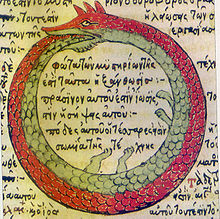
C. J. Jung believed that it had a meaning of infinity and wholeness, and that the alchemists used it as a symbol for the integration and assimilation of the opposite and as a symbol of immortality.
The circle is a recurring symbol in various mythologies, often representing unity, wholeness, and eternity. For example, in Norse mythology, the circle represents the eternal nature of life as described in the myth of Jörmungandr or World Serpent that encircles the world and bites his own tail. In ancient Greek mythology, the circle is associated with the divine and the infinite and is often used to represent the unity and wholeness of the universe. In many indigenous cultures, the circle is used to represent the interconnectedness of all things and the cycles of life and death.
This cycle of life and death was the theme in Disney's 1994 animated feature film 'The Lion King' with its theme song 'The Circle of Life' by Elton John (The Lion King Wiki). Here's a short dialogue from the film where Mufasa teaches Simba about the circle of life:
Mufasa: Everything you see exists together in a delicate balance. As king, you need to understand that balance and respect all the creatures, from the crawling ant to the leaping antelope.
Simba: But, Dad, don't we eat the antelope?
Mufasa: Yes, Simba, but let me explain. When we die, our bodies become the grass, and the antelope eat the grass. And so, we are all connected in the great Circle of Life.
(source: https://lionking.fandom.com/wiki/Circle_of_Life_(concept))
Plato
In Plato’s philosophy, especially in the dialogue Timaeus, the Circles of Same and Other refer to the principles of unity and identity and the principles of multiplicity and difference. The cosmic soul or world-soul (ψυχὴ τοῦ κόσμου) consists of three elements: ταὐτὸν, θάτερον and οὐσία (35A.1), or the principle of Same (unity and rest), of Other (variety and motion) and of Essence, which signifies the identification of these two in one conscious intelligence or universal Mind.
Θάτερον represents the multitude of finite souls and sensible perception. Each soul must also have ταὐτὸν, otherwise it would not have οὐσία, it would not substantially exist. In addition, space and time are secondary forms of θάτερον. Plato also associates the Circle of Other with sure opinions and true beliefs (δόξαι καὶ πίστεις βέβαιοι καὶ ἀληθεῖς, 37B.12) and the Circle of Same with reason and knowledge (νοῦς ἐπιστήμη, 37C.1)
The Circle of Same and the Circle of Other are interconnected and interdependent. The Circle of Same is the source of the Circle of Other, and the Circle of Other is a reflection or participation in the Circle of Same. The Circle of Same is eternal and unchanging, while the Circle of Other is temporal and changing.
Plotinus
In the philosophy of Plotinus, the circle is a powerful metaphor that is used to represent the structure and nature of reality. This metaphor is central to Plotinus' concept of the One, the ultimate source and principle of all existence. The circle also represents the process of emanation, which is the way in which the One gives rise to the lower levels of reality. Just as a circle has no beginning or end, the process of emanation is continuous and eternal, with each level of reality being a reflection of the One.
Furthermore, he uses the circle to illustrate the relationship between the One and the lower levels of reality. Just as the center of a circle is the source of all its radii, the One is the source of all existence and the center from which all things emanate. The lower levels of reality, represented by the radii, are connected to the One and dependent on it for their existence.
And finally, the circle also represents the return to the One, which is the ultimate goal of all existence. Just as a circle completes itself by returning to its starting point, the soul's journey through the lower levels of reality is a process of returning to the One and achieving unity with it.
Proclus
If you divide bodiless things into soul and intellect, you will say that the circle has the character of Intellect, the straight line that of Soul. This is why the Soul, as it reverts to Intellect, is said to move in a circle.
[Commentary on Euclid, 147.12]
Nicholas of Cusa
Nicolas of Cusa uses the metaphor of the infinite circle to represent the identity of God, which he describes as the Maximum:
Omnis enim diversitats in ipso est identitas.
For in the Maximum all difference is identity.
[De Docta Ignorantia, I.XXI.63]
Haec omnia ostendit circulus infinitus sine principio et fine aeternus, indivisibiliter unissimus atque capacissimus.
The unity is exhibited by the infinite circle, which is eternal, without beginning and end, indivisibly the most one and the most encompassing
[ibid, I.XXI.64]
Nicolas of Cusa also assumed a geometrical circle as the symbol of absolute truth, which we can never fully attain and therefore of which we remain ignorant. We can only approximate it ("squaring the circle").
Intellectus igitur qui non est veritas numquam veritatem adeo praecise comprehendit, quin per infinitum praecisius comprehendi possit, habens se ad veritatem sicut polygonia ad circulum, quae quanto inscripta plurium angulorum fuerit, tanto similior circulo.
Therefore, the mind, which is not the truth, never comprehends the truth so precisely that it can be comprehended more precisely to infinity. The mind relates to truth like polygons to a circle. The more angles the inscribed polygon has the more similar it is to the circle.
[ibid, I.III.10]
Schelling
To see how Schelling used the metaphor of a circle in describing his philosophy of absolute identity, watch the video Schelling's Absolute Identity.
Hegel
Hegel uses the idea of a circle to explain more clearly his dialectical method. The dialectical process involves the development and resolution of contradictions. Each principle in his philosophy involves a contradictory principle, both of which are sublated in a higher union that contains both. The higher union or synthesis in turn becomes a new principle which continues the dialectical process in a cyclical movement. This process is shown in his book Science of Logic (Wissenschaft der Logik).
Andries Sarlemijn created the following diagram showing Hegel's circles of dialectic based on his Science of Logic (Hegel's Dialectic, D. Reidel Publishing Company, 1971, p. 7):

Hegel refers to his whole philosophical system, or the Absolute Idea, as a "circle of circles", where each part (e.g. phenomenology, logic, etc.) leads to another to constitute the whole system:
Jeder der Teile der Philosophie ist ein philosophisches Ganzes, ein sich in sich selbst schliessender Kreis, aber die philosophische Idee ist darin in einer besonderen Bestimmtheit oder Elemente. Der einzelne Kreis durchbricht darum, weil er in sich Totalität ist, auch die Schranke seines Elements und begründet eine weitere Sphäre; das Ganze stellt sich daher als ein Kreis von Kreisen dar, deren jeder ein notwendiges Moment ist, so dass das System ihrer eigentümlichen Elemente die ganze Idee ausmacht, die ebenso in jedem einzelnen erscheint.
Each of the parts of philosophy is a philosophical whole, a circle rounded and complete in itself. In each of these parts, however, the philosophical Idea is found in a particular specificality or medium. The single circle, because it is a real totality, bursts through the limits imposed by its special medium, and gives rise to a wider circle. The whole of philosophy in this way resembles a circle of circles. The Idea appears in each single circle, but, at the same time, the whole Idea is constituted by the system of these peculiar phases, and each is a necessary member of the organization.
[Enzyklopädie der philosophischen Wissenschaften, I, §15]
Schopenhauer
Durchgängig und überall ist das ächte Symbol der Natur der Kreis, weil er das Schema der Wiederkehr ist; diese ist in der Tat die allgemeiste Form in der Natur, welche sie in Allem durchführt, vom Laufe der Gestirne an bis zum Tod und der Entstehung organischer Wesen, und wodurch allein in dem rastlosen Strom der Zeit und ihres Inhalts doch ein bestehendes Dasein, d.i. eine Natur, möglich wird.
The genuine symbol of nature is universally and everywhere the circle, because it is the schema or form of recurrence; in fact, this is the most general form in nature. She carries it through in everything from the course of the constellations down to the death and birth of organic beings. In this way alone, in the restless stream of time and its content, a continued existence, i.e., a nature, becomes possible.
[Die Welt als Wille und Vorstellung II, Viertes Buch, Kapitel 41, 543]
Der Wille als Ding an sich ist in jedem Wesen ganz und ungetheilt, wie das Centrum des Kreises ein integrirender Theil eines jeden Radius und ganz in ihm begriffen ist, und doch auch für sich besteht. So ist der Kreis das Sinnbild der Welt.
Will as thing-in-itself is completely and undivided within each being, like the center of the circle is an integral part of each radius and is entirely conceived in it, and yet subsists for itself. Thus, the circle is the symbol of the world.
[Der hanschriftliche Nachlass - Band 4, I - Die Manuskriptbücher der Jahre 1830-1852, p. 103]
Schopenhauer called the content or extension of a concept its sphere and represented it as a circle. If a concept is wholly contained
within another concept, it can be shown as a circle within a circle, for example:

A sphere can also include two or several other concepts which exclude one another and at the same time fill the sphere:
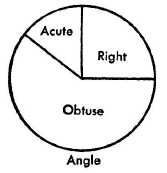
Or two spheres include each a part of the other:

And two spheres lie within a third, yet do not fill it:
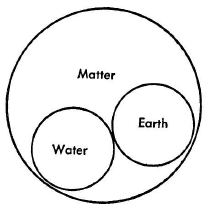
Auf diese Fälle möchten alle Verbindungen von Begriffen zurückzuführen sein, und die ganze Lehre von den Urteilen, deren Konversion, Kontraposition, Reciprokation, Disjunktion.
All combinations of concepts may be referred to these cases, and from them can be derived the whole theory of judgments, of their conversion, contraposition, reciprocation, disjunction.
[Die Welt als Wille und Vorstellung I, Erstes Buch, 51-52]
According to Schopenhauer, nature can be viewed either from the standpoint of the individual or of the universal, from the center or the periphery respectively:
Ihr Centrum nämlich hat sie in jedem Individuo: denn jedes ist der ganze Wille zum Leben. Daher, sei dasselbe auch nur ein Insekt, oder ein Wurm, die Natur selbst aus ihm also reder: ‚Ich allein bin Alles in Allem: an meiner Erhaltung ist Alles gelegen, das Uebrige mag zu Grunde gehn, es ist eigentlich nichts.‘ So redet die Natur vom besonderen Standpunkte, also von dem des Selbstbewusstseins aus, und hierauf beruht der Egoismus jedes Lebenden.
Thus nature has her center in every individual, for each one is the entire will-to-live. Therefore, even if this individual is only an insect or a worm, nature itself speaks out of it as follows: “I alone am all in all; in my maintenance is everything involved; the rest may perish, it is really nothing.” Thus nature speaks from the particular standpoint, from that of self-consciousness, and to this is due the egoism of every living thing.
[Die Welt als Wille und Vorstellung II, Viertes Buch, Kapitel 47, 687]
The universal standpoint, which is the consciousness we have of other things, is the objective knowledge which abstracts from the particular to which knowledge refers. It considers nature from the outside, from the periphery, and in that perspective, the individual is nothing.
Nietzsche
Nietzsche revived the old Stoic concept of eternal recurrence or return, which states that time repeats itself in an infinite loop and that exactly the same events will occur over and over again in exactly the same way for eternity.
Dieses Leben, wie du es jetzt lebst und gelebt hast, wirst du noch einmal und noch unzählige Male leben müssen; und es wird nichts Neues daran sein, sondern jeder Schmerz und jede Lust und jeder Gedanke und Seufzer und all unsäglich Kleine und Grosse deines Lebens muss dir wiederkommen, und alles in derselben Reihe und Folge...
This life as you now live it and have lived it, you will have to live once more and innumerable times more; and there will be nothing new in it, but every pain and every joy and every thought and sigh and everything unutterably small or great in your life will have to return to you, all in the same succession and sequence...
[Die fröhliche Wissenschaft, §341]
Denken wir diesen Gedanken in seiner furchtbarsten Form: das Dasein, so wie es ist, ohne Sinn und Ziel, aber unvermeidlich wiederkehrend, ohne ein Finale ins Nichts: „die ewige Wiederkehr“. Das ist die extremste Form des Nihilismus: das Nichts (das „Sinnlose“) ewig!
Let us think this thought in its most terrible form: existence as it is, without meaning or aim, yet recurring inevitably without any finale of nothingness: "the eternal recurrence". This is the most extreme form of nihilism: the nothing (the "meaningless"), eternally!
[Der Wille zur Macht, §55]
Ralph Waldo Emerson
Ralph Waldo Emerson's essay "Circles" published in 1841:
The life of man is a self-evolving circle, which, from a ring imperceptibly small, rushes on all sides outwards to new and larger circles, and that without end. The extent to which this generation of circles, wheel without wheel, will go, depends on the force or truth of the individual soul.Read full version of essay
Hermeneutic Circle
The hermeneutic circle (German: hermeneutischer Zirkel) describes the process of understanding a text hermeneutically. It refers to the idea that one's understanding of the text as a whole is established by reference to the individual parts and one's understanding of each individual part by reference to the whole. The circle is a metaphor for the procedure of transforming one's understanding of the part and the whole through iterative recontextualization.
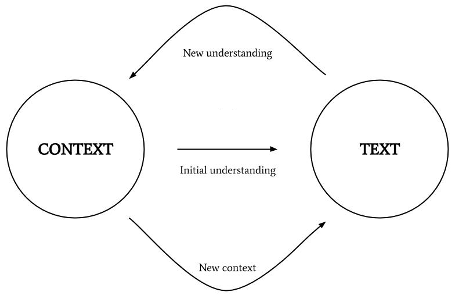
This concept originated with St. Augustine and was further developed by philosophers like Friedrich Schleiermacher and Wilhelm Dilthey. It emphasizes that meaning is contextual and linked to the interpreter’s situation. In essence, understanding a text involves circular movements between its components and the overall context, enriching our grasp of its significance.
C. G. Jung
In Jungian psychology, the circle or mandala is seen as a symbol of the Self, which signifies the unity of consciousness and unconsciousness and represents the psyche as a whole. The center represents the Ego, whereas the Self is the greater circle as a whole which includes the center.

Jung believed that mandalas, which often appear in our dreams, represented an unconscious attempt by the psyche to restore personal balance and wholeness in the face of emotional or psychological chaos.
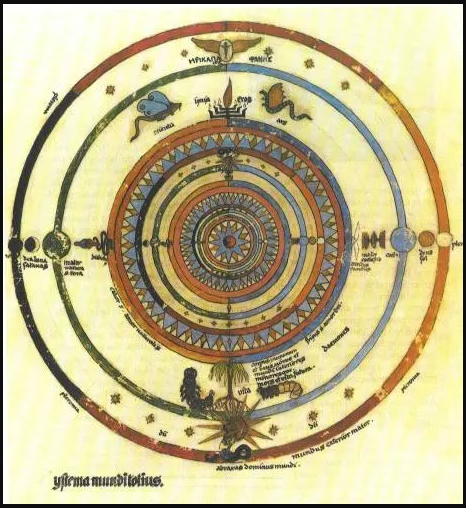
The 'squaring of the circle' is one of the many archetypal motifs which form the basic patterns of our dreams and fantasies. But it is distinguished by the fact that it is one of the most important of them from the functional point of view. Indeed, it could even be called the archetype of wholeness.
[Archetypes of the Collective Unconscious, §715]
Epistemology
In epistemology, the circle metaphor often refers to circular reasoning or a circular argument (aka the fallacy of petitio principii or begging the question). Circular reasoning occurs when the conclusion of an argument is included in the premises, creating a loop where the argument supports itself but doesn't provide any independent justification. In this context, the circle metaphor is used to highlight the problem of relying on assumptions that are ultimately based on the conclusion one is trying to prove.
For example:
- A is true because B is true
- B is true because C is true
- C is true because A is true
It is said that passion makes one think in a circle.
[Oscar Wilde: The Picture of Dorian Grey]
Willard Van Orman Quine uses the circle to explain the development and boundary of scientific knowledge. What we know represents the interior of the circle, whereas what is on the outside of the circle (circumference) represents the boundary of our knowledge or what we do not yet know, our ignorance so to speak. With the advance of scientific knowledge, the circle widens, but so does the number of questions.
Kazimierz Twardowski, the founder of the famous Polish philosophical school called the Lviv-Warsaw School, uses the reverse direction from the circumference of a circle to its center as a way of describing the process of cognition, thereby making truth – the circle's center – the aim of philosophy:
Like all radii of a circle, although they come from different points of the circumference, connect and meet in the center of the circle, the same is for us who want for all the directions of work and philosophical beliefs in our Society to pursue that one aim, the exhibition of truth.
[Przemówienie na otwarciu Polskiego Towarzystwa Filozoficznego we Lwowie (Address on the occasion of the inauguration of the Polish Philosophical Society in Lvov), Przegląd Filozoficzny, 7, 293–243]
Religion
The famous saying that God is "a sphere of which the center is everywhere and the circumference nowhere" is first found in a pseudo-Hermetic treatise of the 12th century ("sphaera infinita cuius centrum est ubique, circumferentia nusquam").
The early Christian theologian Maximus the Confessor used the concept of the “circle” to describe the unity and interconnectedness of God’s nature:
Just as at the center of a circle there is one single point where all the straight lines which come out from it are undivided, in the same way, whoever has been judged worthy of ‘seeing in God’ knows, without concepts and with simple knowledge, all the ideas of created things.
[Mystagogia, 187]
Buddhism
The wheel of life (bhavacakra) represents the cyclic existence (samsara) of life through karma and rebirth.

The meanings of the different parts of the diagram are [see Encyclopedia of Buddhism]:
- The images in the hub of the wheel represent the three poisons of ignorance, attachment and aversion.
- The second layer represents karma.
- The third layer represents the six realms of cyclic existence.
- The fourth layer represents the twelve links of dependent origination.
- The fierce figure holding the wheel represents impermanence.
- The moon above the wheel represents liberation from cyclic existence.
- he Buddha pointing to the moon indicates that liberation is possible.
The circle is also used to represent different ideas of Buddhist teaching, in what is called the Dharma Wheel (dharmachakra). The meaning of the different parts of the wheel are:
- The round shape of the wheel represents the perfection of dharma, the Buddha's teaching.
- The rim of the wheel represents meditative concentration and mindfulness, which hold practice together.
- The hub represents moral discipline.
- The spokes indicate different concepts, such as the Four Noble Truths, the Eightfold Path, the ten directions, the twelve links of dependent origination.
Upanishads
तद्यथा रथनाभौ च रथनेमौ चाराः सर्वे समर्पिताः, एवमेवास्मिन्नात्मनि सर्वाणि भूतानि, सर्वे देवाः, सर्वे लोकाः, सर्वे प्राणाः, सर्व एत आत्मनः समर्पिताः
As in a wheel, all spokes are joined together at the hub and rim; so too, all things, all gods, all worlds, all lives, all separate-seeming selves are joined together in the self.
[Brihadaranyaka Upanishad, 2.5.15]
तमेकनेमिं त्रिवृतं षोडशान्तं शतार्धारं विंशतिप्रत्यराभिः .अष्टकैः षड्भिर्विश्वरूपैकपाशं त्रिमार्गभेदं निमित्तैकमोहम्
We know Him with one hub, three divisions, sixteen ends, sixteen supports (spokes), six sets of eight each, whose one noose has innumerable forms, whose paths are distinguished as three and whose delusion arises out of two causes.
[Svetasvatara Upanishad, 1.4]
The verse envisions creation as a moving wheel (chakra), as a manifestation or projection of Lord Shiva. In the macrocosm it represents
the Purusha, the Cosmic Being who is mentioned in the Vedas as a combination of the Cosmic Soul (Isvara) and the Cosmic Body (the material universe).
In the microcosm it represents each embodied soul or a living being (jiva)
[source: https://www.hinduwebsite.com/brahmawheel.asp].
Kandinsky
Kandinsky's painting "Circles in a Circle" shows his fascination with the circle as a symbol of harmony, balance and cosmic significance. The painting features a large black circle surrounded by 26 smaller, overlapping circles of varying sizes and colors, intersected by straight black lines.
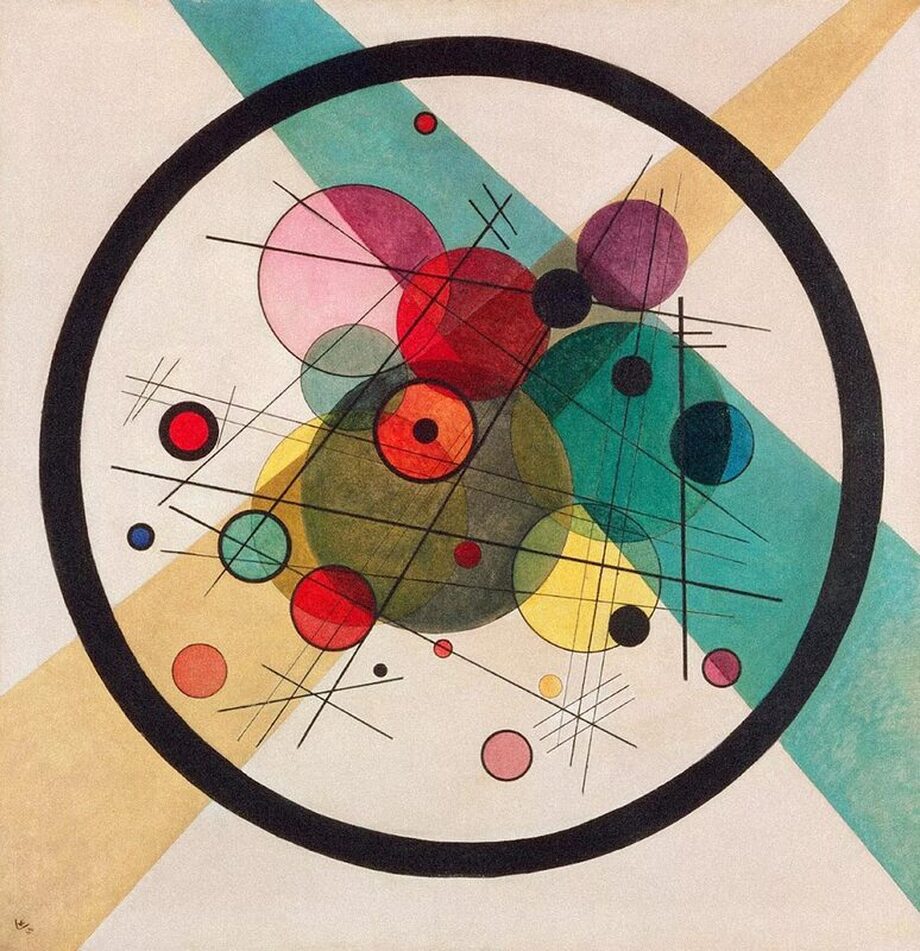
For Kandinsky, the circle represented the synthesis of the greatest oppositions, combining the concentric and excentric in a single form, and in balance. He believed that the circle had symbolic, cosmic significance, reflecting the harmony of the universe. As a symbol of unity and wholeness, the circle represents the artist's quest for a deeper understanding of the universe and our place within it.